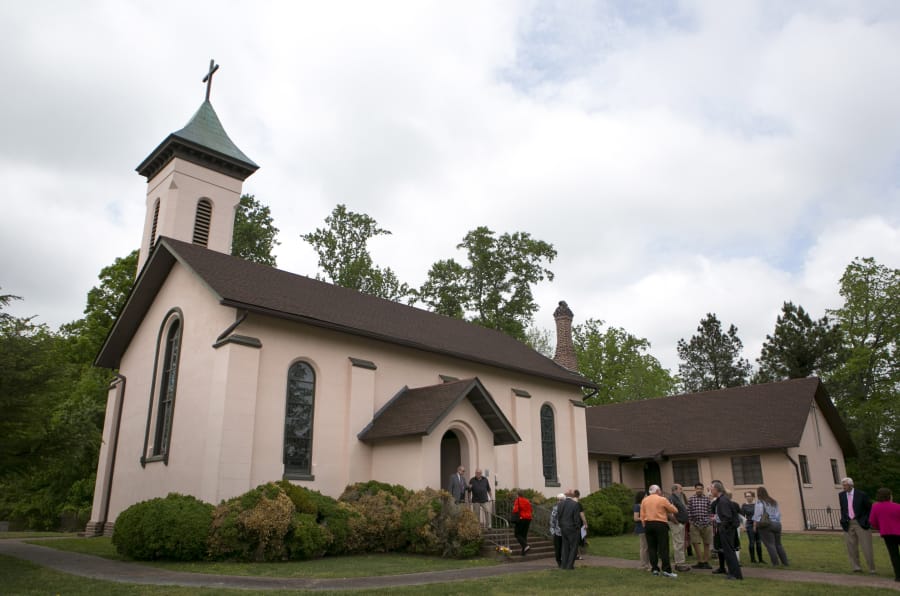DISPUTANTA, Va. — Long before American independence, before the Pilgrims even landed at Plymouth Rock, there was Martin’s Brandon Church.
And now, the Rev. Eve Butler-Gee looks at her flock at the same Martin’s Brandon Episcopal Church in amazement. “They’re faithful. Every single one of them is engaged and active,” she said. But then again, it’s no wonder: “They’ve been doing this for 400 years, and they’re not about to stop now.”
The church, one of the oldest in the United States that still operates, celebrates its 400th birthday this year. And for many families in the rural congregation, the pink-colored house of worship near the James River has been part of their family stories for a very large portion of that time.
“We’ve been coming here for seven generations. At least. We don’t have any records before the Civil War,” said Alecia Redfearn, 31, as the sixth-generation Martin’s Brandon mom juggled Caroline, 3, and Bennett, 4 weeks — the seventh generation.
Redfearn spent her childhood here and never left, and she soaked up more than the light streaming in through the stained-glass window that, she can readily point out, is etched with the name of a Titanic survivor. “We live in the history here. That’s why I like history so much,” she said. “We take the ferry over to Williamsburg. You go by Jamestown. You think, ‘This is where America started.’ ” Today, shaped by that upbringing, she teaches history to students in grades six through 11.
Churchgoers chatting at the after-services lunch — as they ate fried and barbecued chicken, green beans and mac ‘n’ cheese, lemonade and sweet tea, and plate after plate of desserts — reeled off the family names of grandfathers and great-grandmothers, spinning a web of relationships that soon seemed to entwine almost everyone in the room.
Butler-Gee didn’t know that she herself had a family connection to Martin’s Brandon when she learned that her first assignment upon being ordained as an Episcopal priest, as a second career in 2012, would be at the oldest Episcopal church in the country. Her remarkable rediscovered family history was the subject of celebration on May 6, the church’s most recent event commemorating its quadricentennial anniversary this year.
The parish of Martin’s Brandon decided to celebrate four centuries of history with four events, one for every hundred years. So the community first reviewed the 17th century, starting with John Martin, one of the original settlers on the first boat from Britain to Jamestown, Virginia’s first permanent colony. Martin arrived in 1607 and endured the first brutal winters that nearly destroyed the infant settlement: The colony had 490 residents in October 1609 and just 60 still living six months later. According to a church history, those remaining colonists took a vote on whether to stay. The sole resident who voted against abandoning the New World was Martin.
Martin and the others stayed, and he acquired land, which he named “Brandon” in honor of his wife’s family name. Sometime between 1613 and 1618 — the church is choosing to celebrate 400 years in this year — a congregation started worshiping on his land, at Martin’s Brandon. Historical documents indicate that by 1618, the church had a log building and a minister.
In his will, a wealthy parishioner who died in 1658 left 2,000 pounds of tobacco to pay for repairs or rebuilding the church, and another 1,000 pounds of tobacco to pay for a silver communion set. That’s the set Butler-Gee used May 6 during the communion service.
The community has also reviewed the 18th century, when the congregation grew large enough for a new church building in 1723, and when a parishioner donated a silver baptismal bowl in 1731 that’s been used for every baptism at Martin’s Brandon ever since.
Last week, the discussion turned to the 19th century — when post-Revolutionary backlash against the Anglican church, with its close ties to the king of England, left the Martin’s Brandon congregation so reduced in size that it worshiped outdoors, under a long, wooden arbor roofed with pine boughs. The minister who helped revive the congregation, and brought it to the point in 1856 that it could build a proud, pink-hued Tuscan-style building with a soaring bell tower, the building Martin’s Brandon still meets in today — was the Rev. Charles Minnigerode.



